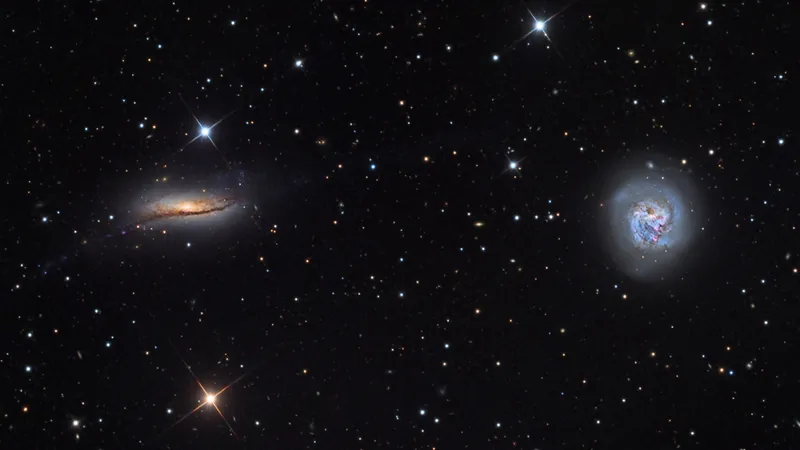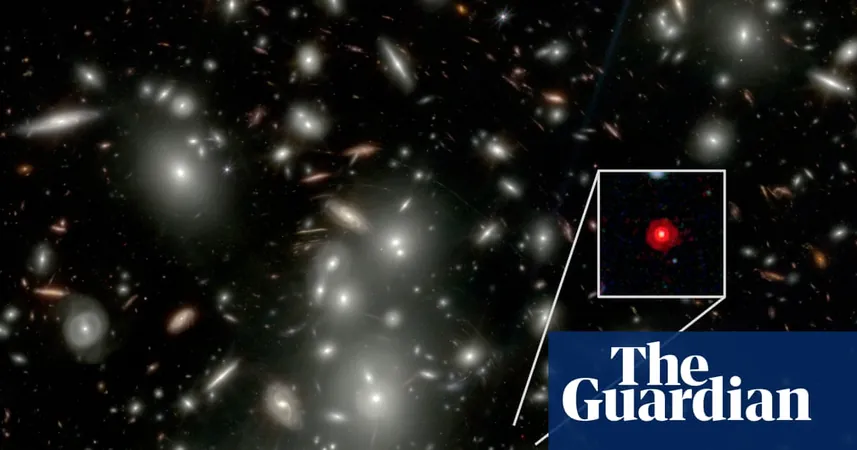
Galactic Collision: A Glimpse into the Future of the Milky Way and Andromeda
2025-08-22
Author: Ken Lee
A Cosmic Encounter Unfolds
Recent observations of two colliding spiral galaxies could reveal tantalizing insights into the future of our own Milky Way and its closest counterpart, Andromeda. The revelations, published in the Monthly Notices of the Royal Astronomical Society, explore the mysteries shrouding satellite galaxies and their orbits.
A Dance of Galaxies
Nestled 88 million light-years away, the pair of galaxies—NGC 5713 and NGC 5179—are locked in a cosmic embrace, rapidly approaching each other at a distance of just 300,000 light-years. Surrounding them are a bevy of satellite galaxies, remnants from the early universe thought to have coalesced through a massive dark matter halo.
A Swarm or a Plane?
Traditionally, cosmological theories suggest that these smaller galaxies should orbit their larger hosts in a random, cloud-like fashion. However, intriguing observations reveal that many of the Milky Way's dwarf galaxies, as well as Andromeda's, orbit in a structured manner—aligned along a co-rotating plane. This peculiar behavior raises questions about existing cosmological models.
Unraveling the Mystery of Dwarf Galaxies
For the first time, researchers have identified a thin, co-rotating plane of dwarfs around NGC 5713 and NGC 5179. "Before the galaxies began to approach, these satellites likely orbited randomly, but now they are forming a flattened structure around the center of mass," explains astronomer Sarah Sweet from the University of Queensland.
Confirmations and Speculations
Fourteen dwarf galaxies have been confirmed to orbit this cosmic pair, with more suspected but yet unverified. Notably, these satellites are grouped into two subcategories that orbit the larger galaxies in the same plane, hinting at gravitational dynamics at play.
Milky Way and Andromeda: The Future Collision
The Milky Way and Andromeda, currently separated by 2.5 million light-years, are on a collision course expected to culminate in a dramatic merger in roughly 4 billion years. Interestingly, a recent analysis suggests that while there’s only a 50% chance of an immediate collision, gravity will inevitably draw them back together.
Are We Different?
As astronomers delve into what makes the Milky Way and Andromeda unique, NGC 5713 and NGC 5179 serve as vital case studies. The transformation of their satellite galaxies into a structured plane could inform our understanding of similar processes in our own galactic backyard. Researchers led by Helmut Jerjen are analyzing why satellite orbits become flattened in this cosmic dance.
A Giant Puzzle to Solve
These latest findings challenge traditional cosmological models, which struggle to account for the observed planes of satellites. Some scientists propose reconsidering the role of dark matter, while others call for updates to existing simulations to match new data. Despite the distance, the Milky Way and Andromeda still exhibit satellite behaviors that have yet to be fully understood.
Peering into Our Galactic Future
Ongoing observations by the Hubble Space Telescope are meticulously tracking the motion of Andromeda's dwarf galaxies, with future studies promising to reveal their history and the implications for our galaxy's evolutionary path. As we decipher the mechanics of these cosmic mergers, we inch closer to understanding not only our galactic fate but the very nature of the universe.

 Brasil (PT)
Brasil (PT)
 Canada (EN)
Canada (EN)
 Chile (ES)
Chile (ES)
 Česko (CS)
Česko (CS)
 대한민국 (KO)
대한민국 (KO)
 España (ES)
España (ES)
 France (FR)
France (FR)
 Hong Kong (EN)
Hong Kong (EN)
 Italia (IT)
Italia (IT)
 日本 (JA)
日本 (JA)
 Magyarország (HU)
Magyarország (HU)
 Norge (NO)
Norge (NO)
 Polska (PL)
Polska (PL)
 Schweiz (DE)
Schweiz (DE)
 Singapore (EN)
Singapore (EN)
 Sverige (SV)
Sverige (SV)
 Suomi (FI)
Suomi (FI)
 Türkiye (TR)
Türkiye (TR)
 الإمارات العربية المتحدة (AR)
الإمارات العربية المتحدة (AR)